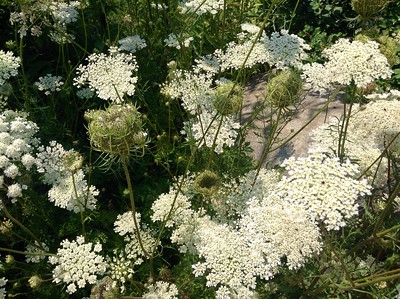Queen Anne’s Lace Plant is a beautiful flower that blooms in white, but has a striking blue inside. Here are some fun facts about Queen Anne’s Lace Plants.
The scientific name of the Queen Anne’s Lace plant is Daucus carota. It can be planted in USDA hardiness zones 3 to 9a although it might not survive colder climates (heirlooms varieties will). Plant seeds 1/4 inch deep and thin seedlings to 20 inches apart. Queen Anne’s Lace Plant: Growing Queen Anne’s Lace And Care.
Queen Anne’s Lace Plant Information
They like full sun or partial shade and moist soil conditions with good drainage. However, the roots should not be disturbed once they are established; do not divide plants. Consistent pruning encourages more flowers while preventing the plants from becoming invasive. In zones 3-9a, plants can be grown as annuals or biennials, but in colder areas they are grown as perennials that return every Spring.
Queen Anne’s Lace Plant was brought to America by early colonists and immigrants with a similar climate to Europe. However, Queen Anne is credited for bringing these plants over from Britain in 1702 after viewing them on a trip to Russia. These plants were most likely cultivated by the English settlers prior to their journey over seas. This plant is native to Eurasia and has been used for various purposes since ancient times.
The earliest known use of this plant dates back nearly 2000 years ago in Roman culture where it was believed that eating Queen Ann’s Lace would help to soothe the nerves. It was also used as a tea substitute by early colonists and even used as an ingredient in Coca-Cola before it became illegal. The name is derived from Queen Anne of England who at one time was thought to have ordered all Daucus carota plants to be destroyed, but this idea has been proven false and does not appear to be at all related to the actual story of these flowers.

Growing Mulberry Fruit Trees: Care, Description, Uses, & Major Species
Difference between Queen Anne’s Lace and Poison Hemlock
Queen Ann’s Lace and Poison Hemlock both appear very similar, but the main difference is that Queen Anne’s lace has a hairy stem while poison hemlock does not.
In addition, Queen Anne’s lace is only poisonous when white flowers are present on the plant. Note: if you have been exposed to either of these plants, go directly to the emergency room immediately!
Care for Queen Anne’s Lace Herb
The best way to care for these plants is to give them full sun, partial shade, and moist soil conditions. Generally speaking they should be watered once a day if there has been little rainfall. They are adaptable to most soils as long as the pH level is not too acidic or alkaline. Queen Ann’s lace can potentially become invasive so it’s important that the seeds are thinned out after planting in order to avoid overpopulating your garden area.

Elephant Ear Plants Care Tips: Benefits, How to grow Elephant Ear Plants
This plant will typically stay green until October when it begins to die back before the first frost of winter hits. These flowers have few pest problems but may need to be treated for aphids or leafhoppers during certain seasons depending on where you live. It’s also a good idea to put a layer of mulch over the roots once it begins to die back in October.
Queen Anne’s lace plant has been known to be a companion plant for corn and tomatoes, so you will often see it planted around those two crops as well as beans and squash. Early colonists also used this plant as an ornamental herb that would attract butterflies.

Picking Strawberry Fruit: When And How To Harvest A Strawberry
To harvest Queen Anne’s lace flowers you can just pick them from your garden when they are completely open with no white centers remaining. They should be picked on a dry day after the dew has dried off but before 10 am otherwise they might begin to wilt or look wilted if left out too long. These plants typically bloom during August and September every year.
A large bushel will contain about 21-25 stems of flowers and can be stored by wrapping them in newspaper or paper bags that have been folded shut. The cut ends of the stems should not be sealed, so leave them open to allow proper drying.
Store these dried stems in a cool dry place with good air circulation away from direct sunlight. For best results you should use your Queen Anne’s lace within 6 months after harvesting for optimal potency.
